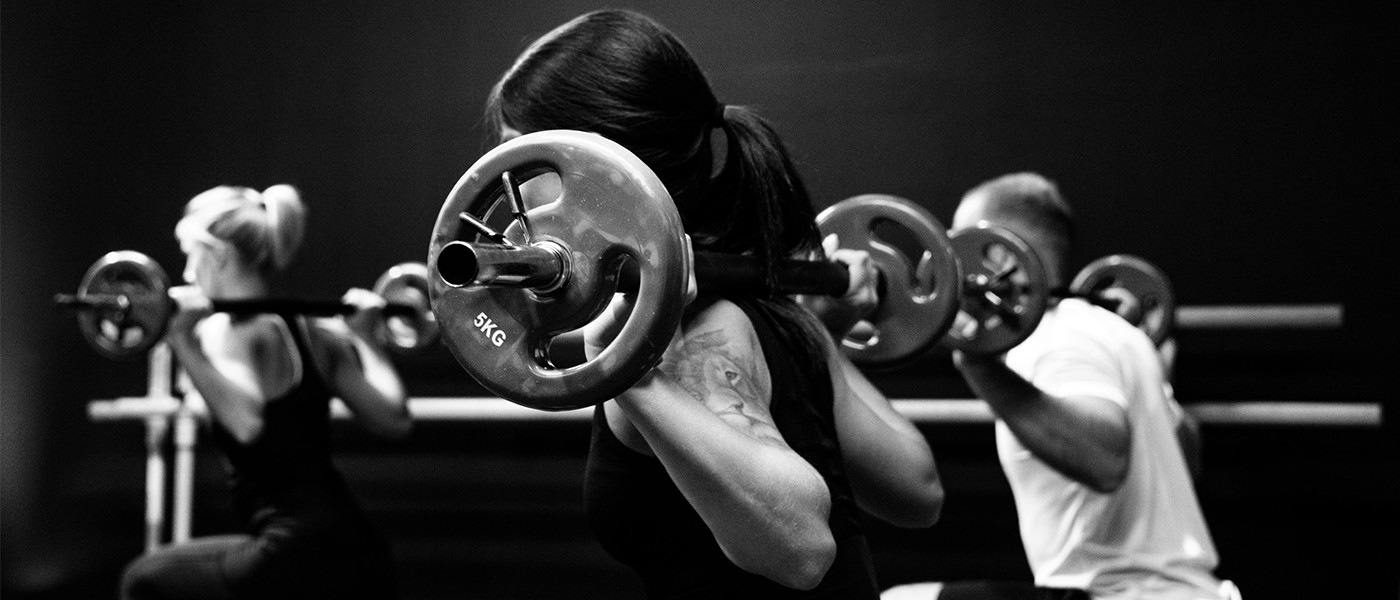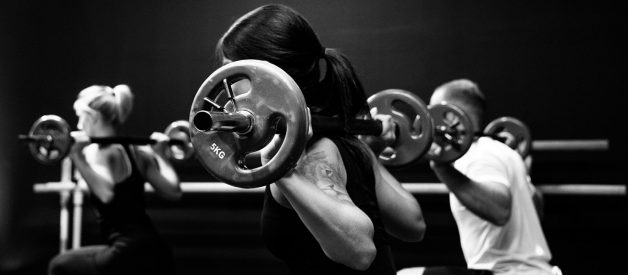Two words: compound movements
 Credit Sven Mieke on Unsplash
Credit Sven Mieke on Unsplash
The body is a complex machine, comprised of many moving parts. Many muscles moving over many bones with the support of many tendons and ligaments. Many functional movements working together to produce many compound movements. Many compound movements creating the bodily motion systems responsible for maneuvering ourselves in so many unique and amazing ways.
When it comes to building muscle to strengthen these motion systems, not all exercises are created equal. We?re not interested in exercises that focus only on one muscle group. Exercises more concerned with pinpoint precision instead of a more wholistic approach.
We want exercises that work multiple muscle groups in one movement. That bend and manipulate the body at multiple points of flexion. Exercises that make us sweat, make us work, make us feel the struggle it takes to achieve our goal.
These are known as compound exercises.
Here are the three kings of the compound exercise kingdom.
Barbell Squats
Crown this bad boy the king of kings. The barbell squat is an absolute monster. It works virtually every muscle in your lower body, including quads, glutes, hamstrings, calves and feet. It requires assistance from many upper body muscle groups, like the lower back, core and trapezius to aid in support and stability. It strengthens the super important joints, tendons and ligaments around your knees and ankles. You burn a crap ton of calories because the energy demand is so high.
Simply put, it?s the best ?bang for your buck?.
Athletic performance is greatly enhanced by barbell squats. When you squat, you get really strong, really fast. When strength improves, explosiveness improves. When you squat, endurance improves. You can push harder for longer. Speed and strength are dialed to the max. It?s you on the field late in the fourth quarter.
To get started
Head to the squat rack at your local gym (you?ll know it from all the grunting) and put the bar on the rack. Just the bar. That?s it. 45 pounds.
It may not seem like a lot, and it?s not. Weight isn?t important yet ? what is important is form. Proper form is essential for performing squats safely and successfully. Take them slow, take them under control, take them down. Watch my buddies Hudson and Brandon if you need a refresh on proper form.
Once you?ve got the form down, it?s time to add squats into your regular workout routine. Start with 3 sets, 10?12 reps each. Rest a full 120 seconds between sets (2 mins). You may have to adjust the weight the first few times until your baseline is established.
You will be very sore after the first few workouts. Plan accordingly.
Once you start making progress, it?s time to alternate repetition ranges and rest periods week by week. As an example:
- week 1: 3 sets, 10?12 reps, 120 seconds rest (2 mins)
- week 2: 4 sets, 7?9 reps, 120 seonds rest (2 mins)
- week 3: 4 sets, 4?6 reps, 180 seconds rest (3 mins)
- week 4: 5 sets, 2?3 reps, 180 seconds rest (3 mins)
The weight you load on the bar should scale up or down in accordance with the current repetition range.
In other words, lift lighter weights on higher repetition days and heavier weights on lower repetition days.
Rinse and repeat. Warm up properly. Make adjustments as needed. Take days off. ALWAYS be thinking about your form.
We?d love for you to write for our Medium publication, In Fitness And In Health! Learn more here.
Bench Press
Known in the fitness world as International Chest Day, Mondays have become synonymous with working out the muscles of the chest. Gym bros and workout enthusiasts alike flock to the gym to perform multiple sets on the bench press, long known as the king of all chest exercises.
Like barbell squats, the bench press works many major muscle groups at one time: the pectorals (chest), deltoids (shoulders), core, lower back and triceps, as well as a bunch of ancillary muscles that work to stabilize the weight throughout the range of motion. As a result, just like barbell squats, strength, speed and stamina become greatly improved, along with connective tissue durability and elasticity.
Culturally, the bench press is known as the standard of strength. The metric by which performance is judged. ?How much do you bench?? is something you?ve probably heard before. People are more likely to know their maximum bench press weight than any other exercise in their routine.
To get started
As is with barbell squats (and every other exercise on this list, frankly) form is crucial. Here?s a video should you need some guidance.
Start with light weight to become accustomed to the feel of the exercise. Let your body discover which muscles to fire and when. Make sure your hands are spaced slightly wider than shoulder width apart. Take the weight down slow, and push up with controlled ferocity.
An example 4-week cycle might look something like this:
- week 1: 3 sets, 12?15 reps, 120 seconds rest (2 mins)
- week 2: 3 sets, 9?11 reps, 150 seonds rest (2:30 mins)
- week 3: 4 sets, 6?8 reps, 180 seconds rest (3 mins)
- week 4: 4 sets, 3?5 reps, 210 seconds rest (3:30 mins)
The weight you load on the bar should scale up or down in accordance with the current repetition range.
Rinse and repeat. Warm up properly. Make adjustments as needed. Take days off. ALWAYS be thinking about your form. You will be very sore after the first few workouts. Plan accordingly.
Overhead Press
Also known as the Military Press, the overhead press was commonly used by the military as a general indicator of one?s strength. This exercise targets the deltoid muscles in the shoulders as well as the triceps and forearms. The core and legs also aid in stabilization and support.
The exercise can be done sitting or standing, with alternating arms or with a hammer grip in which the palms face each other. Performing it standing recruits many more muscle groups in order to maintain proper balance and support, rather than performing it seated.
Want to be a better football, basketball or baseball player? Looking to get a stronger and more developed upper body? The overhead press is your new best friend.
Again, my buddies Hudson and Brandon have a good video displaying proper form.
To get started
Although this exercise can be performed seated or standing, I?d recommend standing only. As I mentioned above, you recruit more muscles this way. This exercise can be performed in the same rack you did your squats, but I?d recommend not performing them on the same day due to the metabolic and physical toll taken.
Put the bar on the rack. Don?t load up any weight. Perform the movement like any other, under control and with appropriate levels of caution and intensity. Anecdotally, I?ve found that this movement takes more time to get used to than the barbell squat or bench press, so be careful.
Once you?re comfortable, place light weight (and i mean light weight, this exercise is harder than you think) on the bar and get started with this example monthly routine:
- week 1: 2 sets, 8?10 reps, 120 seconds rest (2 mins)
- week 2: 3 sets, 6?8 reps, 120 seonds rest (2 mins)
- week 3: 3 sets, 5?6 reps, 180 seconds rest (3 mins)
- week 4: 4 sets, 4?5 reps, 180 seconds rest (3 mins)
The weight you load on the bar should scale up or down in accordance with the current repetition range.
Rinse and repeat. Warm up properly. Make adjustments as needed. Take days off. ALWAYS be thinking about your form. You will be very sore after the first few workouts. Plan accordingly.
Honorable Mention: The Deadlift
The deadlift is another compound exercise well known in fitness circles as an intense muscle builder. Combining raw strength, power and coordination, deadlifts are among the leaders in terms of injecting improved performance into whatever physical activities you enjoy.
The reason deadlifts don?t make the top three is due to safety. Deadlifts, to be frank, are risky. It?s a complicated movement that requires utmost concentration and focus. It constantly toes the line of injury due to the nature of the movement. One slip-up, one too many pounds on the bar, one half-assed repetition and your gym life could be over for a while.
Approach with caution. Talk to a professional. Be careful.
Compound exercises are king. These exercises work multiple muscle groups at a time, giving you the best bang for your buck from a calories burned, muscle strength, and muscle building perspective.
Barbell squats, the bench press, and the overhead press truly are the kings of the castle.
Do your best not to perform these exercises on the same day. I understand this is not always feasible, but compound exercises are incredibly demanding, requiring all your strength and focus to perform safely and effectively.
Use your brain. If you?re feeling tired, decrease the weight on the bar. If you?re sore, perform a complimentary exercise. If your focus isn?t there, perform smaller, more muscle-specific exercises. You?re not going to bring your A-game every workout session, so don?t expect to perform your A-lifts every time either. Check your ego at the door. Safety is most important.
Be safe. Be fit. Be well.
Subscribe to my email list for free workout tips, new blog post alerts and more!
Questions? Comments? Respond below or contact me directly here. I am a certified personal trainer with the National Academy of Sports Medicine.


